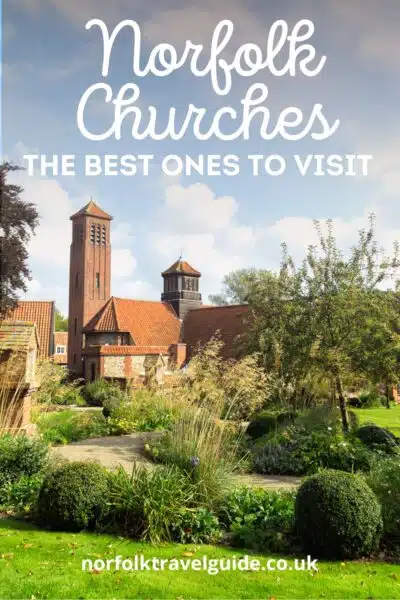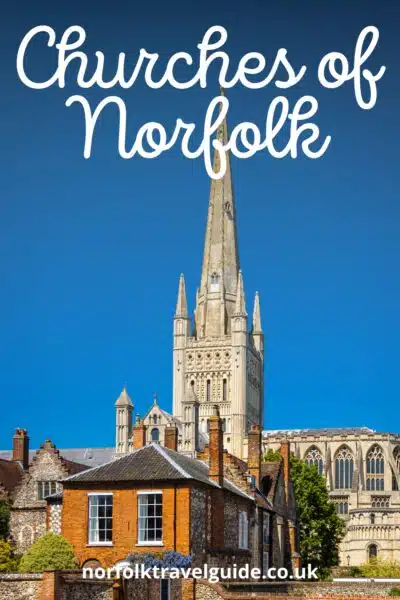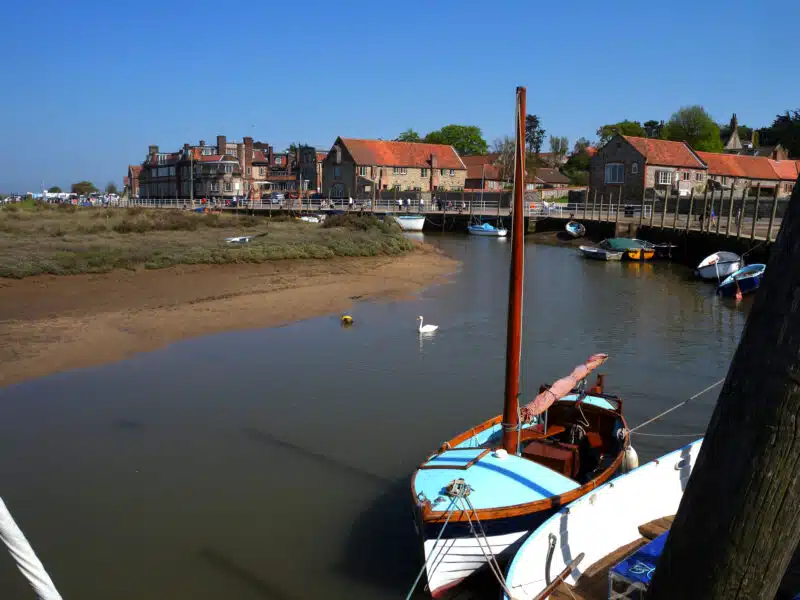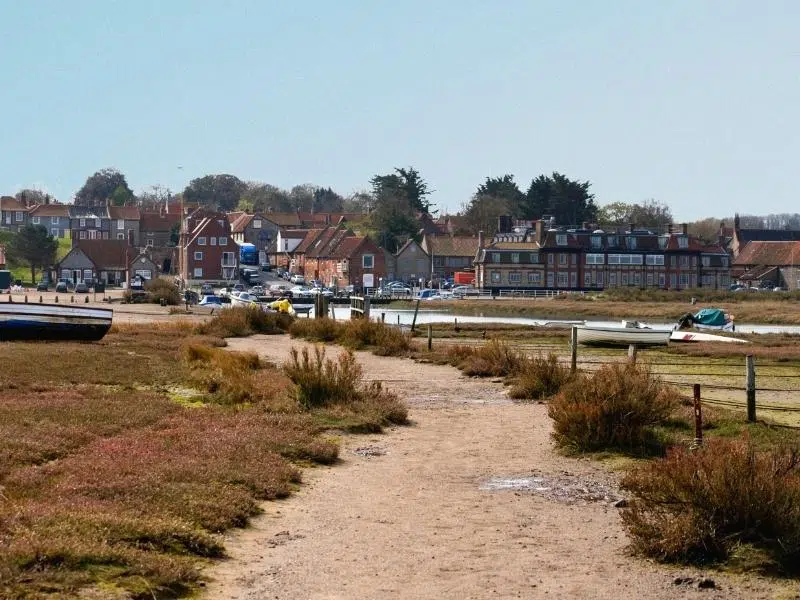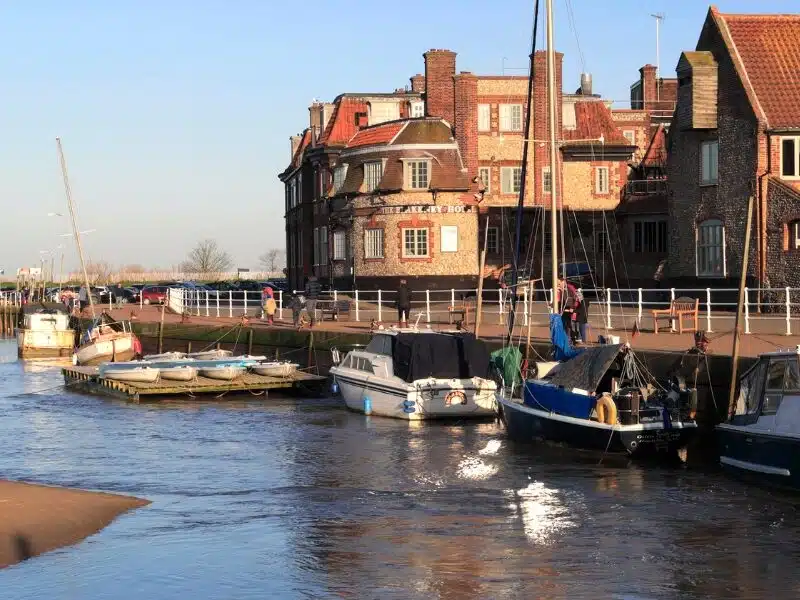Norfolk, a county rich in history and natural beauty, is also home to a wealth of magnificent churches, each with its own unique charm and historical significance.
These sacred landmarks dot the picturesque landscape of the region and offer a fascinating glimpse into the religious, architectural, and cultural heritage of Norfolk.
Although I’m not religious, I love the sense of harmony and peace you find in churches and enjoy admiring the craftsmanship and dedication required to create these remarkable structures. Come with me to see my favourite Norfolk churches!
RELATED POST: The Ultimate Local’s Guide to Norfolk England
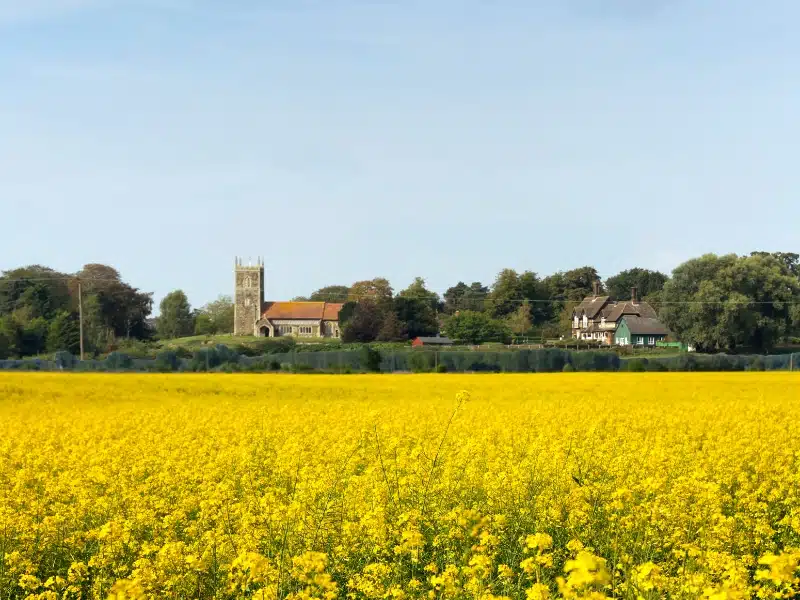
This post may contain affiliate links. If you book something I recommend, I make a small commission without affecting the price you pay!
- History of Norfolk Churches
- Noteworthy Churches in Norfolk
- Norwich Cathedral, Norwich
- St. Peter Mancroft, Norwich
- Wymondham Abbey, Wymondham
- Basilica of Our Lady of Walsingham, Walsingham
- St Mary’s Church, Barton Bendish
- St Nicholas' Church, Salthouse
- St Margaret's Church, Hales
- St Andrews Church, East Lexham
- St Helen's Church, Ranworth
- All Saints Church, Burnham Thorpe
- St Peter’s Church, Gorleston-on-Sea
- St. Michael the Archangel's Church, Booton
- All Saints Hemblington Church, Hemblington
- St. Peter's Church, Walpole St. Peter
- Holy Trinity and All Saints Church, Winterton
- Norfolk Church Tours and Events
- Norfolk Churches Map
- Love it? Pin it!
History of Norfolk Churches
Anglo-Saxon Origins
The history of Norfolk churches can be traced back to the Anglo-Saxon period, which saw the emergence of Christianity in East Anglia.
Many early churches were built using timber and thatch, with some examples, such as St. Peter’s Church in North Elmham, dating back to the 7th century.
These early medieval structures often featured simple wooden towers and were later replaced with stone constructions as architectural techniques evolved.
Norman Conquest Influence
With the Norman Conquest in 1066 came a wave of new architectural styles that influenced Norfolk churches.
The Normans brought with them the Romanesque style, characterised by round arches and solid, robust construction methods.
This can be seen in the impressive Norwich Cathedral, which boasts the second tallest spire and second largest medieval cloisters in England. The cathedral is also unique in that it has retained its original Saxon Bishop’s Throne.
Gothic Architectural Expansion
The Gothic architectural expansion during the late 12th to the 16th centuries greatly impacted the design of Norfolk’s churches.
The use of pointed arches, ribbed vaults, and flying buttresses allowed for taller, airier structures with large stained-glass windows, providing these churches with an awe-inspiring atmosphere.
Among the numerous examples of Gothic architecture in Norfolk, St. Peter Mancroft in Norwich stands out for its beautiful stained-glass windows and elaborate stone carvings.
Reformation and Beyond
The Reformation had a significant impact on Norfolk churches, as it did throughout England.
Many of the county’s medieval churches underwent alterations to align with the new religious practices introduced under Henry VIII, such as the removal of statues and stained-glass windows depicting saints.
Despite these changes, Norfolk’s churches have largely remained faithful to their medieval heritage, with many of them retaining original features from various architectural periods.
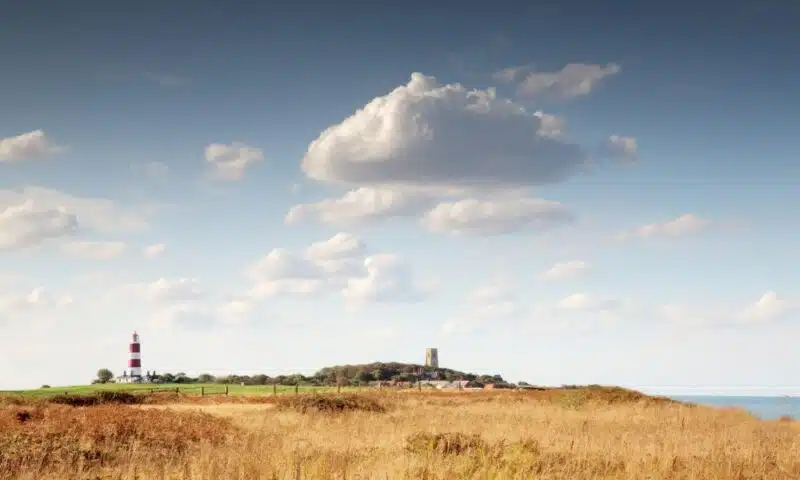
Noteworthy Churches in Norfolk
Norwich Cathedral, Norwich
Built by the Normans between 1096 and 1145, the Anglican Norwich Cathedral is dedicated to the Holy and Undivided Trinity and is unique for its soft creamy Caen limestone exterior and richly adorned interiors.
The fine 96 metre / 315 feet spire is the second highest in England after Salisbury Cathedral. This elegant spire, completed in 1485, is actually Norwich Cathedral’s third documented spire. The first was completed in 1297 but bought down by a storm in 1361 and the second was destroyed in a fire in 1463.
With plenty of Norman character on display, the Cathedral Quarter is a peaceful place to visit for a few hours, especially when you also explore Tombland Alley, home to St. Ethelbert’s Gate (1272) and Erpingham Gate (1420), which lead into the idyllic Close, with its wealth of historic buildings, including the medieval deanery and the Bishop’s Garden, a tranquil spot in the bustling city.
You can discover all this and more by following my Cathedral Close itinerary, which takes you on a 1.5 mile walking tour around the area which is home to buildings dating from the foundation of Norwich Cathedral in the late 11th century, 80 of which are listed.
But wait! Did you know that Norwich actually has two cathedrals? The second, the Cathedral of St John the Baptist is often overlooked in favour of its more historic and elegant neighbour, but it’s well worth a visit and has the added bonus of fabulous city views from the tower.
Built in the 19th century as a gift from the 15th Duke of Norfolk, to show that Catholics could now practice their faith openly, the Roman Catholic Cathedral is one of the finest examples of Victorian Gothic Revival architecture in the UK and contains exquisite carvings, metalwork and stained glass.
The interior of the Cathedral is known for its breathtaking beauty. It features fine stonework, and beautiful stained glass, and is an inspiring and tranquil place of prayer.
RELATED POST: Walks in Norwich – 15 City Walking Routes
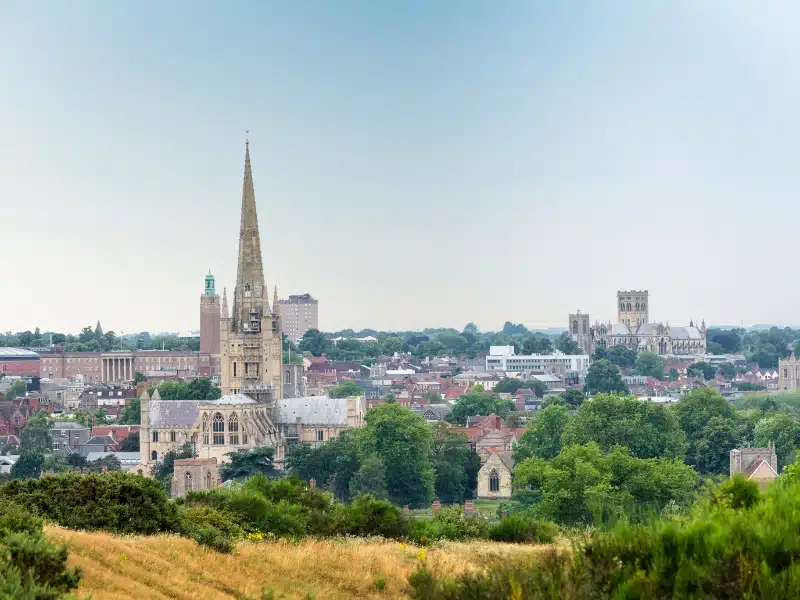
St. Peter Mancroft, Norwich
St Peter Mancroft dates back to the 15th century and is known for its impressive tower, which stands at over 43 metres / 140 feet tall and offers panoramic views of the city.
The largest church in Norwich after the two cathedrals, St Peter Mancroft is sometimes referred to as the ‘civic church’ due to its close association with the city and sits right between the modern-day Forum and Norwich’s 900-year-old open-air market.
The church is open to visitors throughout the year. It features a number of interesting architectural and historical features, including a 15th century font, a collection of Victorian stained glass windows, and a series of intricate carvings depicting scenes from the Bible.
RELATED POST: 32 Amazing Things To Do in Norwich

Wymondham Abbey, Wymondham
Wymondham Abbey is a beautiful and historic building that has stood for over 900 years. The current buildings known as Wymondham Abbey are the remains of a monastery, founded in 1107 by William d’Aubigny, pincerna (a type of butler) to King Henry I and a prominent Norfolk landowner, with estates in Wymondham and nearby New Buckenham.
The monastery was established as a Benedictine foundation in 1107 dedicated to the Virgin Mary. In the 14th century, the abbey was rebuilt in the Decorated Gothic style, and the west tower was added in the 15th century creating the distinctive twin towers silhouette you see today.
The abbey was dissolved by Henry VIII in 1538 during the English Reformation, and the monastic buildings were destroyed. The church was spared and became one of Norfolk’s notable wool churches, so called because a large slice of Norfolk’s wealth from the textile trade went into church building in the 14th and 15th centuries.
The interior of the church, now known as Wymondham St Mary and St Thomas of Canterbury, is impressive, with a vaulted roof and beautiful stained glass windows and features a number of interesting monuments and memorials, including a brass plaque commemorating the founder of the abbey, William d’Aubigny.
RELATED POST: Wymondham: A Window to Norfolk’s Past
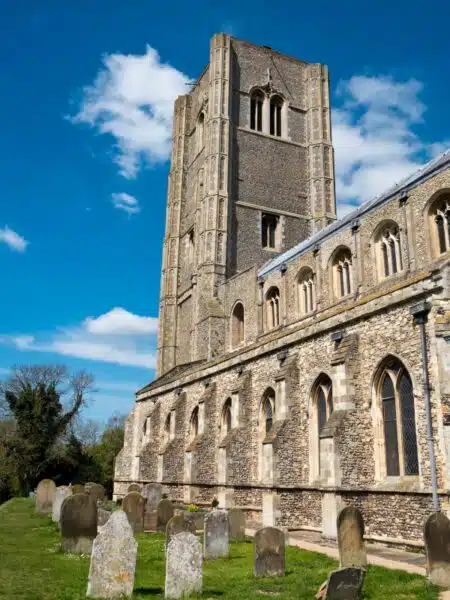
Basilica of Our Lady of Walsingham, Walsingham
The Basilica of Our Lady of Walsingham, also known as the Slipper Chapel or the Chapel of Saint Catherine of Alexandria, is a Catholic basilica and renowned pilgrimage site since the 11th century.
The building was originally constructed in 1340 as a small chapel on the pilgrim route to Walsingham, a major centre of pilgrimage for medieval Christians. Over the centuries, the chapel was expanded and renovated several times, and in 1896 it was purchased by the Roman Catholic Church.
In 1934, the chapel was declared the National Shrine of Our Lady for Roman Catholics in England. In the years since the basilica has become an important site of pilgrimage for Catholics from all over the world, and it is known for its beautiful architecture and rich history.
The architecture of the Basilica of Our Lady of Walsingham is a mix of styles, reflecting the building’s long and varied history. The chapel was originally constructed in the Early English Gothic style, with a simple rectangular plan and a steeply pitched roof.
Today, the basilica includes elements of Gothic Revival, Victorian, and Arts and Crafts architecture. The building’s most striking feature is its ornate west front, which was added in the 19th century and features elaborate carvings and sculptures depicting scenes from the life of Christ and the Virgin Mary.
The interior of the basilica is equally impressive, with a soaring nave, beautiful stained glass windows, and a number of interesting monuments and memorials.
RELATED POST: 21 Museums in Norfolk You Won’t Want to Miss!

St Mary’s Church, Barton Bendish
St Mary’s Church is a redundant medieval Anglican church believed to have been built in the 14th century, and the architectural historian Nikolaus Pevsner was of the opinion that its west door is “one of the best Norman doorways in England”.
A Grade I listed building under the care of the Churches Conservation Trust, St Mary’s underwent significant restoration work in the 19th century, and much of the original medieval stonework was replaced at that time.
The architecture of St Mary’s Church is a mix of styles, reflecting the building’s long and varied history. The church was constructed in the Decorated Gothic style, with a mixture of stone and flint used in the construction.
The church features a number of interesting architectural details, including a beautiful east window with intricate tracery and a striking west tower with a battlemented parapet and pinnacles. Inside, the church has a simple nave with a timber and thatched roof and a chancel with a vaulted ceiling.
The church also features a number of interesting monuments and memorials, including a brass plaque commemorating the founder of the church, Sir Ralph de Hengrave.
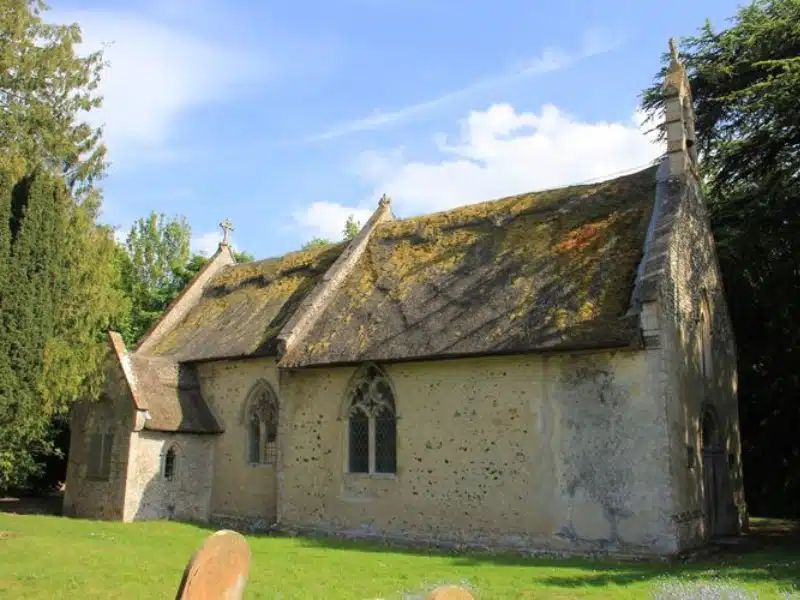
St Nicholas’ Church, Salthouse
St Nicholas’ Church is a historic Anglican Grade I listed church known for its beautiful architecture and rich history. The church was constructed in the late Perpendicular Gothic style, with a mixture of stone and flint used in the construction.
The history of St Nicholas’ Church is closely tied to the history of the village of Salthouse. The church was built at the expense of Sir Henry Heydon of Baconsthorpe Castle, a prominent Norfolk landowner, and was consecrated in 1503. The church played an important role in the life of the village, serving as a place of worship, a centre of community life, and a symbol of the village’s prosperity.
The church features a number of interesting architectural details, including a beautiful west tower with an octagonal spire and elaborate pinnacles. Inside, the church has a nave with a timber roof and a chancel with a vaulted ceiling. The church also features a number of interesting monuments and memorials, including a beautifully carved 15th century lion font.
I love this church for its proximity to the North Norfolk coastline across the marshes – it’s less than half a mile from the sea and makes for some fantastic photo opportunities.
RELATED POST: North Norfolk Coast – 19 Unmissable Highlights
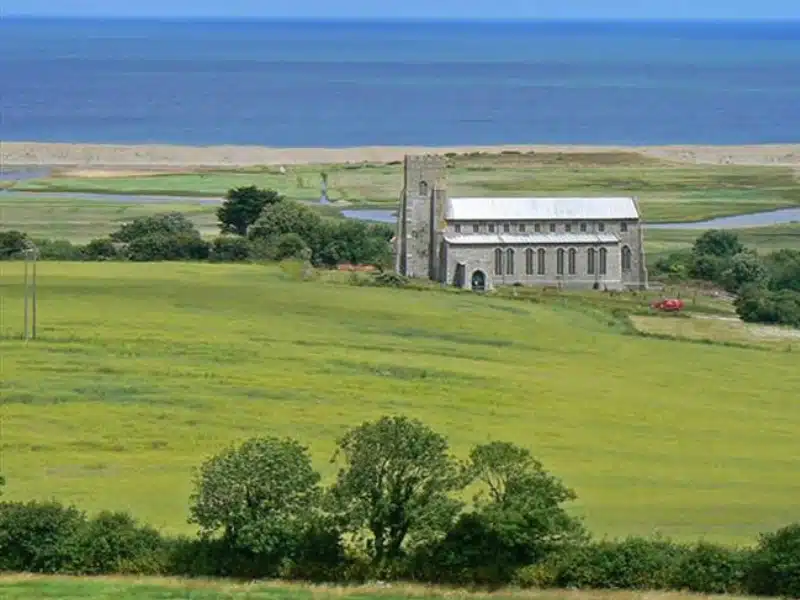
St Margaret’s Church, Hales
St Margaret’s Hales is an enchanting redundant 12th century Norman church set amidst beautiful Norfolk countryside. A Grade I listed building and is known for its stunning Norman architecture, St Margaret’s was constructed in the Romanesque style, with a mixture of stone and flint used in the construction.
The thatched church features a number of interesting architectural details, including a beautiful round tower, with a conical roof and decorative arcading and an intricately carved doorway with bands of richly carved patterns zigzags, stars and rosettes.
Inside the church is simple and rustic with a timber roof and vaulted ceiling in the nave. Medieval faces painted on the walls peer out from across the centuries and the 500-year-old font is carved with angels, lions and roses.
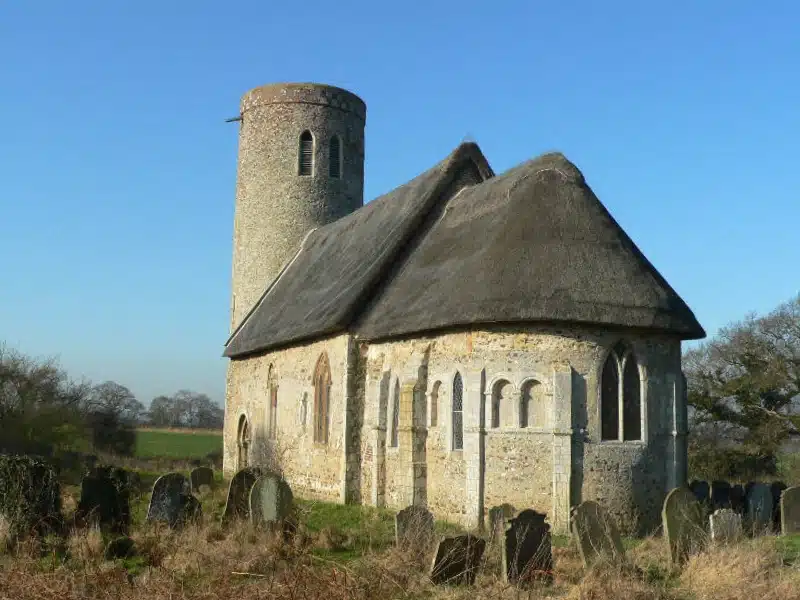
St Andrews Church, East Lexham
St Andrews Church in East Lexham dates back to the Saxon period and is thought to have been built in the 11th century, making it one of the oldest churches in Norfolk.
The Grade I church boasts an impressive round tower made of stone and flint in contrast to the smoother render of the church walls, and an imposing stained glass east window.
The interior is rustic with the nave and chancel running continuously under the single roof. As you enter you’ll see the striking WWI memorial, a painting of St Michael defeating the dragon. There are just seven names, a tragedy for such a small and remote village.
There are 124 round tower churches in Norfolk, with East Lexham and Hales being amongst the best. I love spotting one across the flat fields or surrounded by sheep cropping the grass in the graveyards.

St Helen’s Church, Ranworth
St Helens Ranworth is a picturesque 15th century Grade I listed church situated close to Ranwort Broad. It houses an exceptional medieval rood screen with painted panels depicting various saints, a magnificent hammer beam roof and beautifully carved woodwork.
Climb the 89 uneven steps and two ladders to pass through the trap door to get to the top of St Helen’s Church, otherwise known as the ‘Cathedral of the Broads’. The views from the top across the road and Bure Valley are breathtaking – literally!
RELATED POST: 26 Exciting Things To Do On the Norfolk Broads
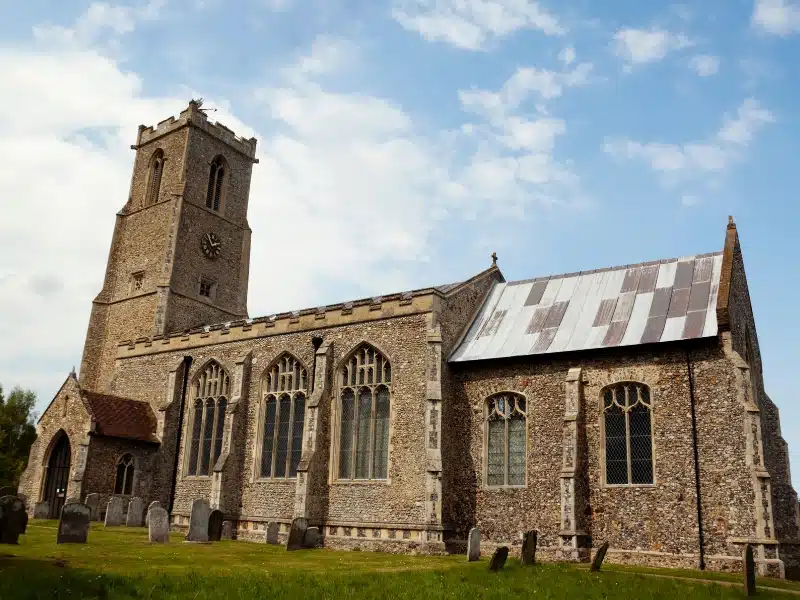
All Saints Church, Burnham Thorpe
All Saints in Burnham Thorpe, the birthplace of Lord Nelson, is a lovely medieval church. The church dates back to the 13th century, with the original building being constructed in the Early English Gothic style, and features a unique double hammer beam roof and an elegant font.
The church is closely associated with Admiral Horatio Nelson, who was born in the village of Burnham Thorpe in 1758 and learnt to sail at nearby Burnham Overy Staithe. Nelson’s father, Edmund Nelson, was the rector of All Saints Church.
Nelson spent much of his childhood in the village, and the church played an important role in his early life. He was baptized in the church, and he and his family attended services there regularly. Nelson’s parents are buried in the church, and a bust of Nelson is set on the north wall of the chancel above the site of his parent’s grave.
RELATED POST: Burnham Overy Staithe: Off-The-Beaten-Path Norfolk
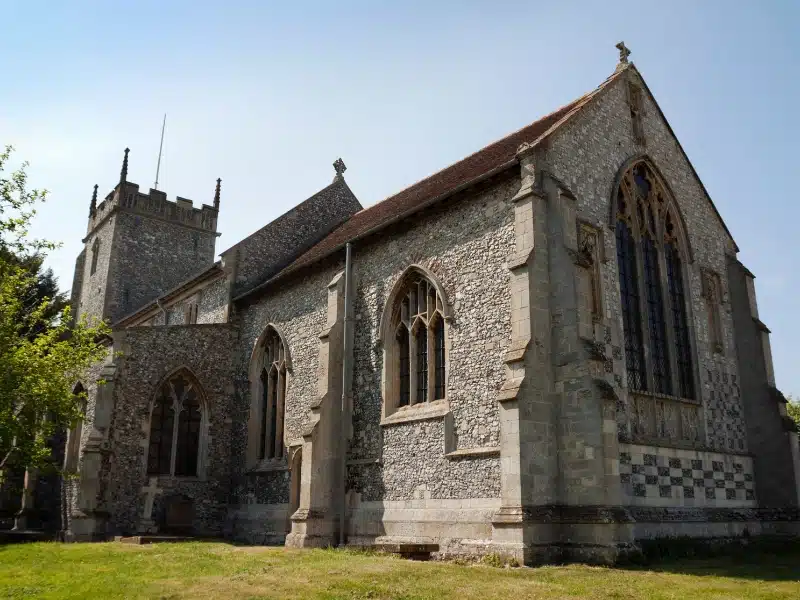
St Peter’s Church, Gorleston-on-Sea
The parish church of St Peter the Apostle Roman Catholic Church in Lowestoft Road was built between 1938 and 1939 and is well worth a visit for its architectural significance and beautiful interior.
The Grade II* listed church is the only complete architectural work by Eric Gill, a famous 20th century sculptor, letter cutter, typeface designer, and printmaker, who was considered a great artist-craftsman during his lifetime, but fell out of favour when revelations about his private life became public in 1989.
The cruciform church is designed around a central altar which then was considered a radical change from the Catholic practice of the altar being at the east end of a church. The tower above the altar is supported on pointed crossing arches which spring from the floor and are repeated throughout the building.
A major feature which is not the work of Gill is the 1963 stained-glass east window, depicting the Risen Christ flanked by his Blessed Mother and St Peter, designed by Joseph Nuttgens, who had been Gill’s friend. Nuttgens’ claimed that he had helped Gill to design the church, but had never been credited, and as Gill had insisted on plain glass in the church, Nuttgens called the colourful east window his ‘revenge on Gill’.
RELATED POST: Gorleston-on-Sea: A Traditional Norfolk Seaside Town
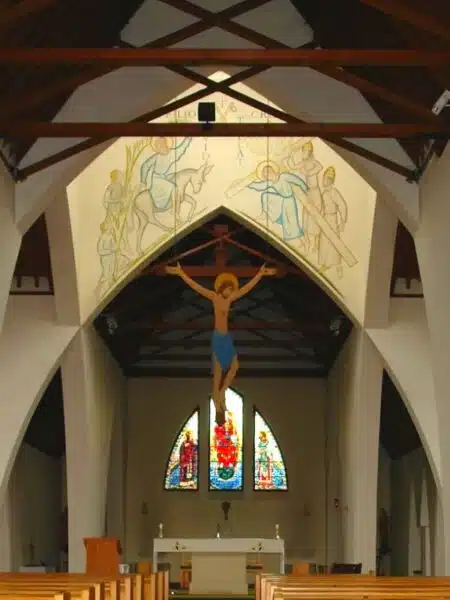
St. Michael the Archangel’s Church, Booton
A 19th century neo-Gothic church, St. Michael the Archangel’s Church is an architectural gem. The redundant church is known for its rich history, and is often referred to as the ‘Cathedral of the Fields’.
The church was built in the 19th century, between 1874 and 1883, by Reverend Whitwell Elwin, a local clergyman who was also an accomplished and somewhat eccentric writer and editor. Elwin was inspired by the Gothic Revival movement and wanted to create a church that would be a fitting tribute to his faith and love of architecture.
The architecture of St Michael the Archangel’s Church is a striking example of the Gothic Revival style, with a mix of French and English Gothic elements and features a number of interesting architectural details, including a nave with a timber roof, a chancel with a vaulted ceiling, and a beautiful east window with intricate tracery.
The most striking feature of the church is its twin west towers, which are slim and set diagonally. They are in three stages, the lower two stages containing elongated blank arcading. The church is constructed in flint with limestone dressings and has tiled roofs.
The church is also known for its beautiful gardens, which were designed by Reverend Elwin himself. The gardens feature a number of interesting plants and trees, including a cedar of Lebanon, which is believed to be over 200 years old.
RELATED POST: The 21 Best Gardens in Norfolk to Visit
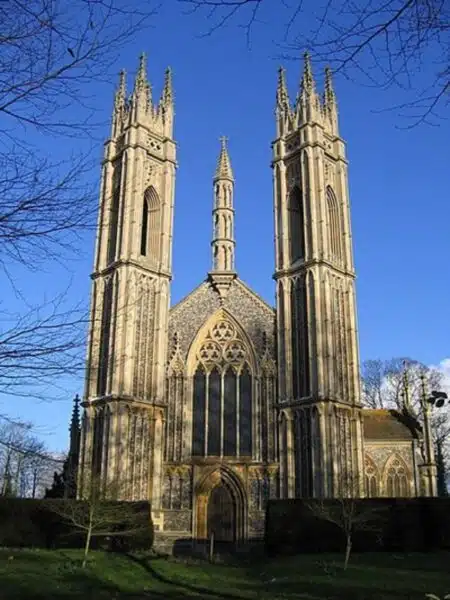
All Saints Hemblington Church, Hemblington
All Saints Church dates back to the 13th century, with the original building being constructed in the Early English Gothic style. Over the years, this Grade I listed church underwent a number of renovations and additions, including the addition of a south aisle in the 14th century and a north aisle in the 15th century.
The architecture of All Saints Church is a mix of styles, reflecting the building’s long and varied history. The church features a number of interesting architectural details, including a beautiful east window with intricate tracery and a striking west tower with a battlemented parapet and pinnacles.
Inside, the church features a number of interesting monuments and memorials, including a unique late medieval wall painting of St Christopher, showing his life before he carried the Christ child across the river, then his torture and death when he would not renounce his new faith. The painting was discovered in 1937, hidden under layers of whitewash.
The church also has a brightly painted 15th-century font and striking 16th-century painted rood screen.
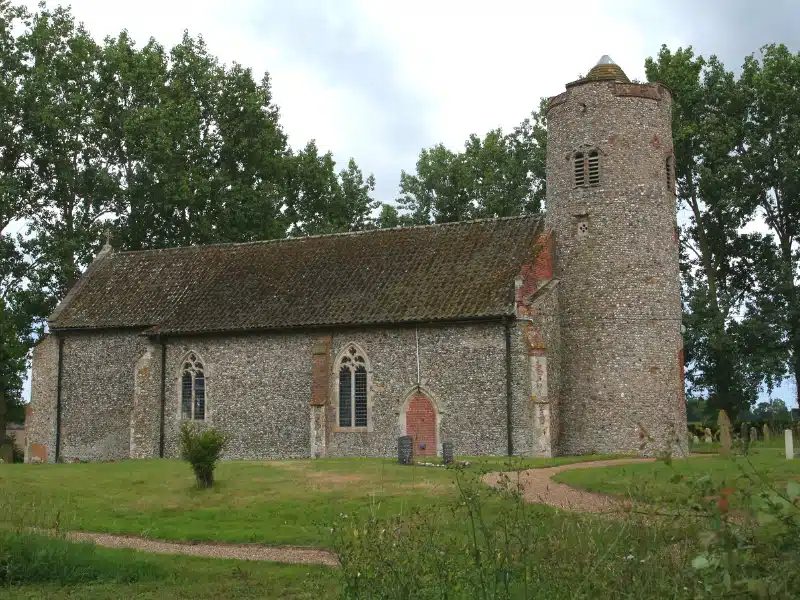
St. Peter’s Church, Walpole St. Peter
St Peter’s Church is a historic Anglican church located in the village of Walpole St Peter and is known as the ‘Cathedral of the Fens’ due to its size and renown. The church dates back to the 12th century and has undergone numerous renovations and additions over the centuries.
Constructed in the Early English Gothic style, the church is known for its impressive tower, which stands over 30 metres / 100 feet tall, is topped with a distinctive octagonal lantern, and is regarded as one of England’s finest parish churches.
The architecture of St Peter’s Church is a striking example of the Perpendicular Gothic style, with a mix of French and English Gothic elements. The church features a number of interesting architectural details, including a beautiful east window with intricate tracery and a striking west tower with a battlemented parapet and pinnacles.
Inside, the church has a nave with a timber roof and a chancel with a vaulted ceiling, a 15th century brass to Sir Thomas Walpole and his wife, and a 17th-century monument to the Walpole family. The church also has a beautifully carved pulpit, which dates back to the early 16th century.
RELATED POST: All the Best Things To Do in King’s Lynn Norfolk
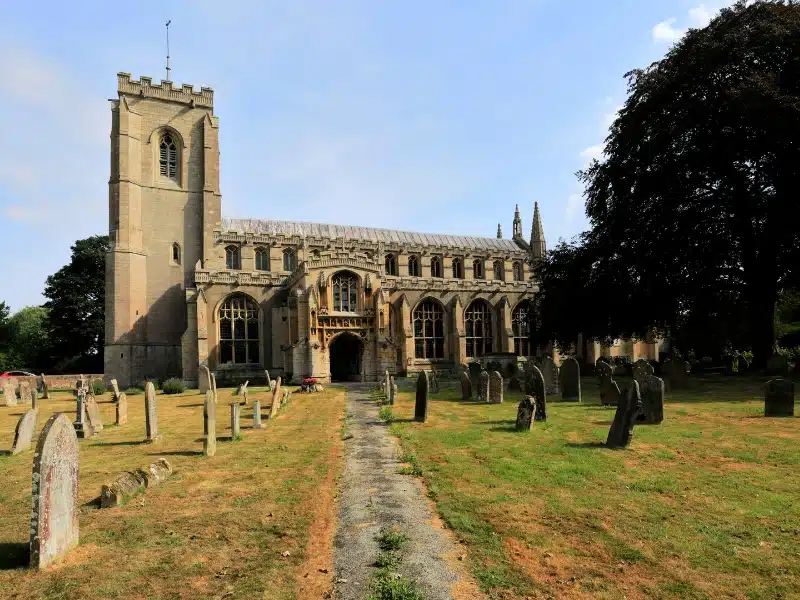
Holy Trinity and All Saints Church, Winterton
One of Norfolk’s great seamark churches, Winterton’s Holy Trinity and All Saints Church has a 39 metre / 127 foot tower often described as a landmark for sailors.
The fishing heritage of Winterton is clear to see as you enter Holy Trinity and All Saints Church. Nets from one of the last fishing boats that made a living from the beach adorn the walls, and at the back of the church is Fisherman’s Corner, with a crucifix carved from ships’ timbers.
Navigation notes from 1846 show that at least ten Norfolk coastal churches were used for taking bearings, when historic mariners rarely had charts and relied on the sun and stars, and observation, to guide them. These so-called seamark church towers were often used as reference points and Trinity House records that a number of ecclesiastical lights were exhibited along the coast in medieval times as a guide to shipping.
Walking across the sand dunes from the beach, you’ll have a view of the 14th century church tower, flanked by 21st century wind turbines.
The tower was restored in 2014 and is open to the public on Saturdays during the spring and summer. Climb to the top for wide-reaching views of the surrounding countryside and coastline. On a clear day, you can see as far as Happisburgh Lighthouse to the north and Caister water tower to the south.
Other seamark churches on the Norfolk coast include St Mary’s Happisburgh, St Mary’s Snettisham, St Nicholas Blakeney and St Peter and St Paul Cromer.
RELATED POST: Winterton on Sea – All You Need to Know Before You Go
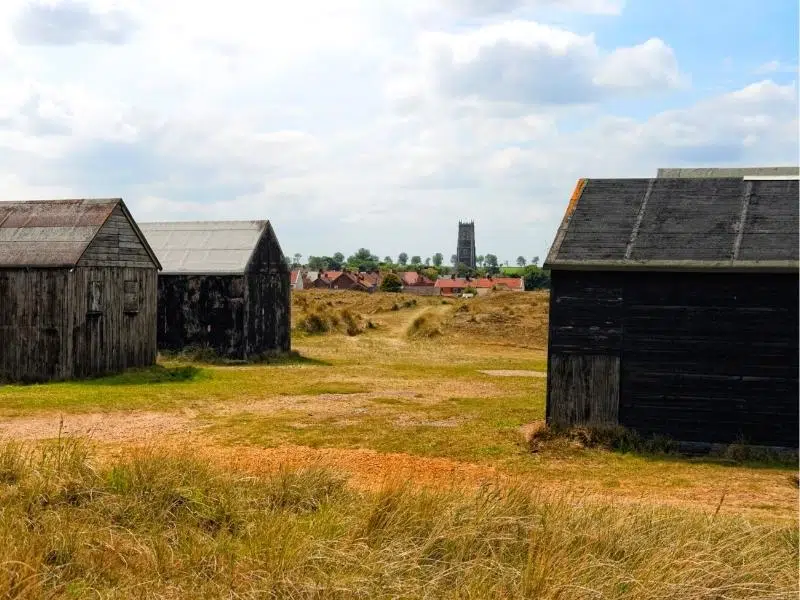
Norfolk Church Tours and Events
Norfolk is home to a vast array of historic churches, with more than 650 spread across the county. Many of these churches are round tower churches, a unique architectural feature found mainly in East Anglia and Norfolk alone is home to over 120 of these structures.
To appreciate this rich heritage, various church tours and events are organized throughout the year, showcasing the religious and architectural history of Norfolk.
Heritage Open Days
Heritage days are held annually in Norfolk, where visitors have the opportunity to explore and enjoy guided tours of churches, cathedrals, and other historic sites.
During these events, visitors can learn about the religious and architectural significance of these beautiful structures and the stories behind their construction.
RELATED POST: What’s On in Norfolk – 70+ Dates for Your Diary in 2023
Open Churches Week
Open Churches Week is another popular event in Norfolk that invites visitors to explore churches that are normally closed to the public. During this week-long event, many churches open their doors and host exhibitions, concerts, heritage trails, and guided tours to engage visitors with their fascinating history and unique architectural features.
Through events like Heritage Days and Open Churches Week, Norfolk strives to celebrate its religious and architectural heritage. By opening their doors and organizing a variety of activities, the county encourages locals and tourists alike to step through the doors of these historic churches, appreciating the stories they have to tell and the beauty they hold within.
Norfolk Churches Map
How to use this map – Use your fingers (or computer mouse) to zoom in and out. Click or touch the icons to get more info about a place, and click the arrow in the box top left to open the index. To add to your own Google Maps account, click the star next to the title of the map.
Have I missed your favourite Norfolk church from my list? Let me know in the comments below so I can pay a visit and add it to this round-up of churches in Norfolk!
Love it? Pin it!
